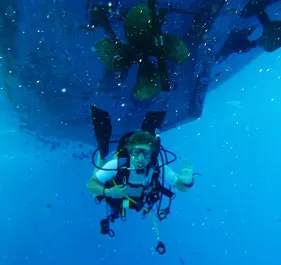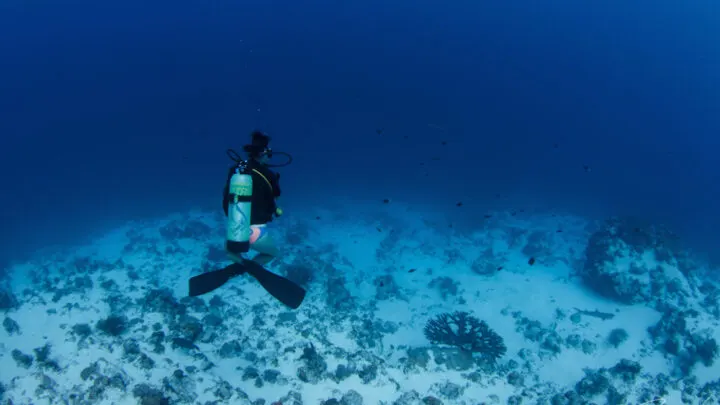Ok, so what exactly is it NITROX? What is Enriched Air? Which one is better? If you’ve just started scuba diving you’ve probably heard the word Nitrox thrown around a fair few times now. But what the hell is it and should you really do the course? We talk to Girls that Scuba member Rhonda Richer for more answers:
What is Nitrox?
The air we breathe is made up of nitrogen, oxygen and many other gases. For the purpose of diving, these other gases are so insignificant that they are ignored, so we say that in every 100 molecules of air, there are 79 nitrogen molecules and 21 oxygen molecules (79/21).
The technical difference between nitrox and enriched air is like the difference between fruit and apples; apples are a specific type of fruit. Nitrox is where the mix between nitrogen and oxygen is not 79/21, but Enriched Air is more than 21 oxygen molecules per 100.
Most recreational divers, as opposed to technical divers, use the term nitrox to mean enriched air.
What are the benefits of diving Nitrox?
A lot of more experienced divers tell new divers “you’ve got to do nitrox!”. “Why?” I hear you ask. There is a misconception that you can dive deeper, but actually it is just the opposite, but you can dive for longer.
Another misconception is if you’re on a diving holiday using nitrox that it will make you feel less tired after doing many dives. Although there is no actual data to prove this, it is repeated by most divers. It could be just the ‘holiday’ effect where you’re more relaxed and there are no pressures.
So what is happening? Going back to your first lessons, you learnt that you have time and depth limits when diving. This is because as you dive your body absorbs the gas that you are breathing and, as you’re under pressure, you absorb more than you would at the surface. This becomes a problem as you ascend and the amount of pressure reduces which, if too fast, will allow those gases to bubble out. As you know oxygen is used in the body for various reasons, however nitrogen is not and therefore is more likely to form bubbles.
The idea behind enriched air, is that if you reduce the amount of nitrogen (by increasing the amount of oxygen) then the risk of bubbles is reduced (note: not eliminated). So extra oxygen = more energy and less nitrogen means your body doesn’t have to work so hard to get rid of the excess.
Sounds brilliant!! But is there a drawback? Why do you have to do a course in it? As mentioned above, as you dive deeper your body is subjected to more pressure. Chemicals, when under pressure and/or more molecules in each 100, react quicker, which for nitrogen isn’t a problem as it’s not used (no reactions) in the body and the number of nitrogen molecules is reduced. Oxygen on the other hand, is used and these speeded reactions can become a problem as more pressure is applied, and more oxygen is available in each breath. This in turn, if not properly limited, have serious consequences when under water.
Doing the PADI Enriched Air course, or any other course of a similar nature, will help you understand the relationship between pressures, gas absorption and why limits are important. If you’re looking to take your diving to a leadership role, e.g. Divemaster or above, then this understanding will help you explain to less experienced divers the why’s and wherefores of dive planning.
What Will I learn in the Enriched Air Course?
- Obviously, with safety as a priority, the hazards of having a gas with a high oxygen content around, including filling cylinders where the pressures are much greater than normal surface.
- How to analyse the gas mix in your tank i.e. find out how many oxygen molecules per 100 (percent), and you have to do it yourself.
- Having found out what the mix is, you learn how to work out your depth and time limits as these are significantly different to diving on air. The exact method of calculation e.g. using tables/formulas, dive computer or a dive planning app, depends on your instructor.
I personally teach how to use a dive computer, but I go through the tables and formula so that my students have an understanding of what is happening inside the computer and get a good understanding of the physics behind the theories. Any good instructor should be willing to go through the formula with you.
Having done the classroom work, you do not actually have to dive on nitrox to complete the course as the only physical difference between diving with nitrox and diving with air is purely the planning (you can’t even taste the difference).
The amount of time needed will primarily depend on how much self-study you do beforehand. If your instructor teaches only the table method, you can expect to spend most of a day ensuring you can work both the tables and the formula. However, when using the computer method it shouldn’t last too long (approx. 3-4 hours) if you have read through and understood the manual.
The cost of the course will depend upon whether the optional dives are to be part of the course, but for the manual, course without dives, and the certification I would expect to pay anywhere from £80 – £120.
Is it for you?
If you are curious or just want to expand your diving knowledge then I would say do it. I would also recommend doing the course if ever you want to go on a diving holiday, where you’re doing multiple dives over multiple days, after all, absorbing less nitrogen can’t be a bad thing. A lot of dive boats now offer nitrox for free if you’re qualified so why not make use of it?

About the Author
Despite working full time in London Rhonda is a PADI Elite instructor and a staff instructor and has been scuba diving since 2010. A pro cold water diver, she is completely addicted to training others and inspiring them to reach their dreams – and was even awarded the Elite 100 award last year – not bad for something that is just her ‘hobby’.

